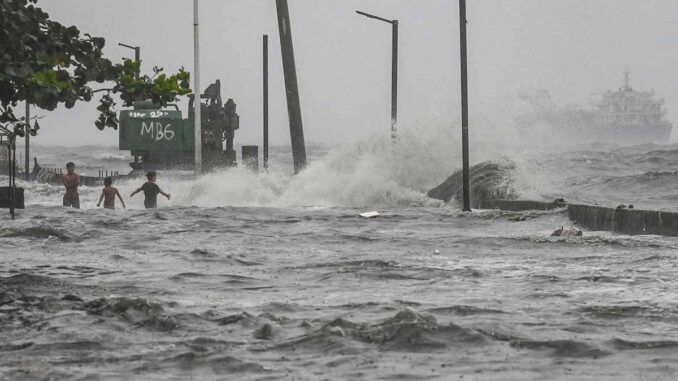
ON Aug. 15, 2024, the Lloyd’s Register Foundation released its “World Risk Poll 2024 Report: Resilience in a Changing World,” the first global survey of people’s perceptions and experiences of risk and safety. Aimed to engineer a safer world, the report reveals the following findings:
– Sixty-two percent of Southeast Asians said they live in a household with a disaster plan known to all members. Two-thirds (67 percent) also believe they could protect themselves and their families from a future disaster.
– Forty percent of Southeast Asians reported experiencing a disaster related to a natural hazard in the past five years.
Heavy rains brought by Tropical Storm Enteng in Manila. PHOTO BY JAM STA ROSA VIA AFP
– Eighty-seven percent of the Philippines have experienced a disaster within the past five years. No other country globally has a higher percentage.
– The top four countries worldwide with the highest proportion of households having a disaster plan are all in Southeast Asia: the Philippines (84 percent), Vietnam (83 percent), Cambodia (82 percent) and Thailand (67 percent).
– Majority of people in all Southeast Asian countries have received at least one disaster warning, with Vietnam (99 percent) and the Philippines (92 percent) ranking highest. This is above the global average for the reach of early warnings, except for Malaysia and Indonesia.
These findings show that Southeast Asia has made significant progress in recent years toward disaster preparedness, with the Association of Southeast Asian Nations playing a key role in disaster risk reduction. Disaster preparedness is crucial in building resilience against natural hazards, as it helps save lives, protect livelihoods and minimize the shock of disasters, and allow people to bounce back faster from them.
Factors affecting readiness
The Philippines is one of the countries most affected by climate change, experiencing increased frequency and intensity of typhoons, floods and rising sea levels. According to the Iseas-Yusof Ishak Institute report, 62 percent of Filipinos consider climate change and extreme weather events as their second-biggest challenge.
While being “disaster-prepared” suggests a sense of readiness and resilience among the population, the reality illustrated by the loss of lives and damages caused by Typhoon Carina reveals significant shortcomings in the nation’s disaster preparedness. Several factors contribute to this vulnerability, demonstrating that many Filipinos remain ill-equipped to handle the impact of natural catastrophes despite widespread efforts.
One critical issue that affects disaster preparedness in the country is inadequate infrastructure. Many areas, especially in rural and coastal regions, lack proper drainage systems and resilient structures. Heavy rainfall associated with typhoons, such as the wrath brought by Typhoon Carina, often leads to severe flooding, which is worsened by poorly planned urban developments. As of Aug. 16, 2024, the National Disaster Risk Reduction and Management Council reported that a total of 1,243 areas across 15 regions experienced flooding due to the combined effects of the southwest monsoon and Typhoons Butchoy and Carina.

Three Asian countries’ disaster-preparedness. PHOTO FROM LLOYD’S REGISTER FOUNDATION WORLD RISK POLL 2023
Another major concern is the accessibility of reliable information regarding disaster preparedness and response. While 92 percent of Filipinos agreed that they have received at least one disaster warning, many communities, especially those in remote areas, may not have received the same. This creates a lack of awareness about impending threats. Moreover, misinformation can spread rapidly through social media, complicating response efforts and leaving individuals unprepared.
Socioeconomic challenges also play a significant role in the country’s disaster readiness status. Many communities face poverty in our country which has a poverty incidence of 15.5 percent among the population as of 2023, leading to insufficient resources for disaster preparedness. Families may lack the financial means to invest in safety measures, such as reinforcing their homes or stocking up on supplies. Furthermore, people living in informal settlements are often at higher risk due to their living conditions’ unstable and hazardous nature. These individuals may find themselves trapped during disasters, unable to evacuate or access necessary resources.
Environmental degradation, such as deforestation, mining and coastal erosion, further exacerbates the impact of disasters. Communities that once relied on natural barriers such as mangroves or forests for protection find themselves increasingly exposed. This environmental vulnerability makes it challenging for Filipinos to effectively prepare for disasters, contributing to the damages observed during incidents like Typhoon Carina.
While the government has disaster preparedness frameworks, implementation can sometimes be inconsistent. A number of low-income local government units struggle with limited funding or resources to execute disaster management plans effectively. Moreover, while community members often exhibit solidarity and support during crises, the lack of training and preparedness at the grassroots level means that many are still unsure of how to respond optimally.
Though Filipinos are often praised for their resilience in the face of disasters, the reality illustrated by Typhoon Carina highlights serious gaps in preparedness. As of press time, the damages that Typhoon Enteng is wreaking are still being assessed. In a landscape where many Filipinos remain vulnerable and exposed, it is not surprising that the Philippines has ranked first in the World Risk Index for two consecutive years (2022 and 2023).
The author is the founder and chief strategic advisor of the Young Environmental Forum and a director of Climate Tracker Asia Inc. He completed a climate change and development course at the University of East Anglia (United Kingdom) and an executive program on sustainability leadership at Yale University (USA). You can email at [email protected].



Be the first to comment